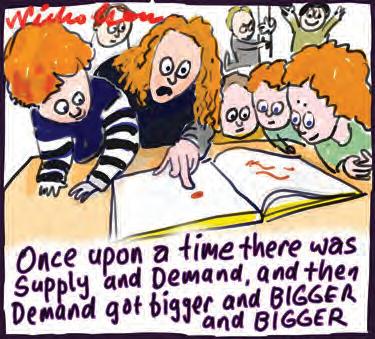
7 minute read
2.4 The law of demand and movements along the demand curve
3. Complete table 2.1 by outlining five important differences between perfect or pure competition, monopolistic competition, oligopoly and perfect or pure monopoly, providing one example of each type of industry. (Note: Sometimes it is hard to be precise here.) (5 marks)
TABLE 2.1 Features of different market structures
Advertisement
Some features of a particular market Perfect/pure competition e.g................ Monopolistic competition e.g................ Oligopoly e.g................
Perfect/pure monopoly
4. 5. 6. 7. 8. 9. 10. 11 12. e.g................ 1. Level of competition or number of firms 2. Level of product differentiation 3. General level of efficiency 4. Level of influence over prices 5. Likely level of market prices paid by consumers Define the following terms: a. market power b. barriers to entry c. homogeneous product d. perfect knowledge. Distinguish the terms price maker and price taker. (2 marks) Look at the following list of single industries or markets found in Australia. Select and research any three of these, and then describe the three most important distinguishing features of each market. (3 marks) Apples at the farm gateA. BankingB. Beef cattleC. Broadband networkD. CinemaE. Container shippingF. LabourG. LawyersH. Medical treatmentI. PetrolJ. Rental propertyK. RestaurantsL. Retail groceriesM. SharesN. TelecommunicationsO. WaterP. WheatQ. Your school’s canteenR. Identify and outline what you believe are the three most important advantages of perfectly competitive markets. (3 marks) The Australian aviation market is an oligopoly, with considerable barriers to entry by new rival firms limiting the level of competition. Entry is difficult. Explain what is meant by barriers to entry and give examples of the types of barriers applicable to the aviation industry. (2 marks) Australian clothing manufacturers operate in a monopolistically competitive market. (2 marks) a. Explain what is meant by the term monopolistic competition. b. Explain the significance of product differentiation in this industry and how might this be promoted by manufacturers of swimwear. In a competitive market, canola producers attempt to use resources in ways that maximise their profits. Explain what is meant by the term profit maximisation. (1 mark) It is possible to get products like snowboards and clothing cheaply using online markets such as eBay. This is partly due to strong competition among rival sellers. For these products, identify and outline one precondition that is normally required for buyers in a perfectly competitive market that may not be fully met using eBay or other online markets. (2 marks) In general, it is claimed that strongly competitive markets in an economy are most likely to help maximise society’s material living standards. Explain why this may be the case. (3 marks) UNCORRECTED PAGE PROOFS
Fully worked solutions and sample responses are available in your digital formats.
2.3 BACKGROUND KNOWLEDGE: How markets make key economic decisions — the big picture
BACKGROUND KNOWLEDGE
• Overview and introduction to the operation of markets 2.3.1 Overview and introduction to the operation of markets Australia has a contemporary market-based or mixed economy. Among other things, this means that the three basic economic questions are largely answered by reference to market prices rather than following the directions of government. 1. The ‘what and how much to produce’ question Consumers decide what types of goods (e.g. chocolate bars, tourist accommodation, butter, guns) or services (e.g. educational, health, financial, entertainment) will be produced by what they demand or purchase in various markets. As a general rule, firms respond to these instructions from the market or price system by only producing wanted and profitable things. 2. The ‘how to produce’ question The market allows businesses to make key decisions about the specific production methods to be used (e.g. the combinations of labour and capital equipment) to make each good or service. Generally, businesses select the cheapest, most efficient and most profitable methods to produce goods and services. 3. The ‘for whom to produce’ question The market helps to make most decisions about how the nation’s goods, services and incomes that have been produced will be shared or divided between members of society. Here, people’s incomes and their purchasing power largely depend on the value of their economic contribution, as valued by the market or price system. FIGURE 2.7 In answering the ’how to produce’ question, the use of robotics and technology is often cheaper for producers than using labour, especially in countries where wage levels are high. UNCORRECTED PAGE PROOFS
FIGURE 2.8 How Australia’s price or market-based system makes key economic decisions and allocates resources between alternative uses
Step 1
Step 2
Step 3
Because of scarcity, people cannot have all the goods and services they would like. This forces them to choose between satisfying competing wants. In a market-based economy, these choices or decisions are made through the operation of the price system (also called the market mechanism) that involves the forces of demand and supply. Together, consumers or buyers (demand) and producers or sellers (supply) negotiate the equilibrium market price of each good or service, similar to what occurs in an auction. This establishes relative prices — the price level of one good or service compared with that of another. However, when the non-price conditions affecting buyers (i.e. demand) and/or non-price conditions affecting sellers (i.e. supply) change in the market so initially there is either a market glut or a market shortage. This causes the equilibrium market price to either rise or fall, creating price signals. That act as positive or negative incentives. These signals provide information or instructions to the owners of resources, helping them to make key economic decisions guided by self-interest and their desire to maximise profits. Profit-seeking owners of natural, capital and labour resources watch these price signals and use them to help make key decisions about how they should allocate resources. The signals help them to select the type and quantity of particular goods or services to produce (‘What and how much to produce?’). They also help them to decide the cheapest, lowest cost and most profitable production methods (‘How to produce?’), as well as deciding how the goods, services and incomes should be shared or distributed (‘For whom to produce?’). • If there is a rise in the market price for a particular good or service, relative to the price of other items, the production of this product usually becomes relatively more profitable, a positive incentive thus attracting more resources into this type of production (assuming that firms’ production costs or the prices paid for resources have not changed, especially in an upwards direction). In turn, higher profits lead to higher levels of production and income for those in this industry. • If there is a fall in the final equilibrium market price of a particular good or service, relative to that for producing other items (assuming there is no change in firms’ production costs or prices paid for resources, especially not downwards), the production of this item becomes relatively less profitable (a negative incentive). This tends to repel resources and cut production, along with the incomes of those connected with this industry. With this general background in mind, we are now ready to drill deeper into our study of microeconomics. Microeconomics looks at how the smaller units like consumers, producers or firms, an individual market, and a single industry making up our overall economy behave; what motivates their choices and what are the effects of their decisions. Our study of microeconomics will involve a closer look at the following areas: • buyers in a market and the law of demand (the demand curve) • sellers in a market and the law of supply (the supply curve) • how market equilibrium is reached • how new non-price factors or conditions affecting the demand and supply curves alter the equilibrium price and affect the key economic decisions that are made • how changes in relative prices effect the way resources are allocated between different uses. Economists often use demand–supply diagrams or models to better understand how a competitive market works, make key economic decisions and allocate resources efficiently to help satisfy our many needs and wants. Each diagram represents a competitive market for a single good (e.g. sunglasses) or a specific service (e.g. live entertainment). These diagrams or graphs are especially useful when analysing the impact on market prices of price and non-price factors or conditions that affect the behaviour of buyers (i.e. demanders) and sellers (i.e. suppliers).

FIGURE 2.9 In Australia’s market economy, demand and supply help determine prices that, in turn, signal to owners of resources how those productive inputs should be used. UNCORRECTED PAGE PROOFS










